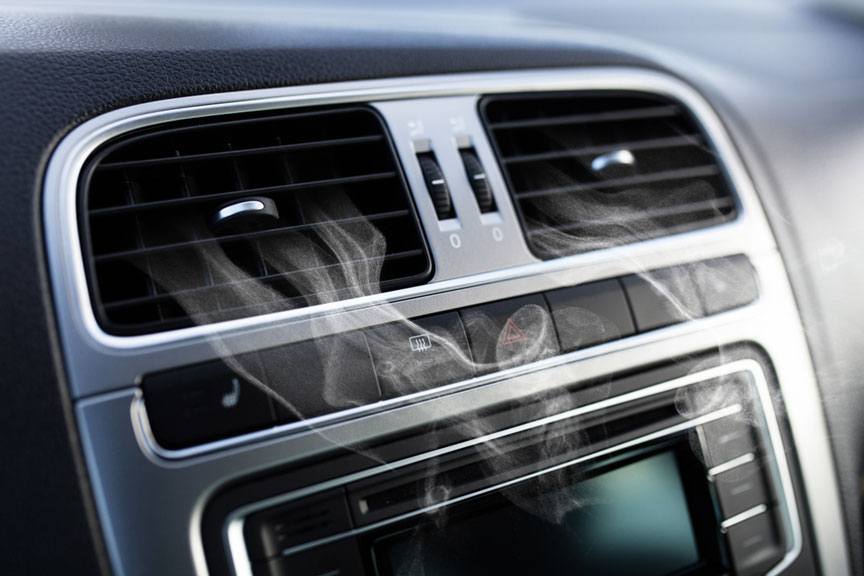How To Remove The Smell Of Smoke In A Car

Removing the pervasive odor of smoke from a vehicle's interior presents a significant challenge for automotive professionals. The complexity arises from smoke particles embedding themselves deeply within various materials, including upholstery, carpets, headliners, and even ventilation systems. A successful odor removal strategy requires a multi-faceted approach, considering the chemical properties of smoke and the material science of the vehicle's interior.
Initial Assessment and Preparation
Before embarking on any cleaning process, a thorough assessment of the vehicle is crucial. This includes identifying the severity of the smoke damage, the types of materials affected (e.g., leather, fabric, plastic), and the presence of any pre-existing conditions, such as mold or mildew, which can exacerbate the odor problem. A visual inspection, coupled with a careful olfactory examination, allows for a tailored treatment plan.
The first step in the removal process is a comprehensive cleaning. This involves:
- Vacuuming: Employ a high-powered vacuum with a HEPA filter to remove loose debris and surface-level smoke particles from all interior surfaces, including carpets, seats, headliners, and vents. Special attention should be paid to crevices and seams.
- Surface Cleaning: Use appropriate cleaners for each surface type. Leather surfaces require specialized leather cleaners and conditioners to prevent damage and dryness. Fabric surfaces should be treated with upholstery cleaners designed to lift embedded odors. Plastic surfaces can be cleaned with a mild all-purpose cleaner.
- Air Filter Replacement: Replace the cabin air filter, as it is a primary source of trapped smoke particles. Consider upgrading to a filter with activated carbon for enhanced odor absorption.
Ozone Generators: A Powerful but Risky Solution
Ozone generators, also known as ozone shock treatment machines, are commonly used to eliminate smoke odors. These devices produce ozone (O3), a highly reactive gas that oxidizes odor-causing molecules. While ozone generators can be effective, they must be used with caution.
Pros:
- Effectiveness: Ozone can penetrate deeply into materials and eliminate a wide range of odors, including smoke.
- Speed: Treatment times are relatively short, typically ranging from 30 minutes to several hours.
Cons:
- Material Damage: High concentrations of ozone can damage certain materials, such as rubber, plastic, and some fabrics. Prolonged exposure can cause discoloration, cracking, and degradation.
- Health Risks: Ozone is a respiratory irritant and can be harmful to humans and animals. The vehicle must be completely unoccupied during treatment, and thorough ventilation is required afterward.
- Reliability Considerations: The effectiveness of ozone generators can vary depending on the machine's output, the severity of the odor, and the ambient temperature and humidity.
Technical Specifications: Ozone generators are rated by their ozone output, typically measured in milligrams per hour (mg/h). Higher output machines are more effective for severe odors but also pose a greater risk of material damage. Treatment times should be carefully monitored and adjusted based on the specific vehicle and odor level.
Alternative Odor Removal Techniques
Several alternative odor removal techniques offer safer and more controlled solutions:
- Activated Carbon Filters: Placing bowls of activated carbon or using activated carbon air purifiers inside the vehicle can slowly absorb odors over time. This is a gentler approach that is suitable for mild smoke odors.
- Enzyme-Based Cleaners: Enzyme-based cleaners contain enzymes that break down odor-causing molecules. These cleaners are effective on fabric surfaces and carpets but may require multiple applications.
- Steam Cleaning: Steam cleaning can help to loosen embedded smoke particles and disinfect surfaces. However, it is important to use a low-moisture steam cleaner to prevent water damage.
- Hydroxyl Generators: These devices produce hydroxyl radicals, which are similar to ozone but are considered to be safer for both materials and humans. Hydroxyl generators are less likely to cause material damage but may be less effective for severe odors compared to ozone generators.
Ventilation System Treatment
The vehicle's ventilation system is a common reservoir for smoke odors. To effectively treat the system:
- Disinfectant Sprays: Use a specialized disinfectant spray designed for automotive ventilation systems. These sprays are typically applied through the air intake vents while the blower motor is running.
- Evaporator Cleaning: Clean the evaporator core, as it can accumulate moisture and mold, which can contribute to odors. This may require accessing the evaporator housing and using a specialized cleaning solution.
Maintenance and Prevention
After successful odor removal, regular maintenance is essential to prevent the return of smoke odors. This includes:
- Regular vacuuming and cleaning of the interior.
- Promptly addressing any spills or stains.
- Using air fresheners or odor absorbers to maintain a fresh scent.
- Avoiding smoking in the vehicle.
Future Trends
The automotive industry is continuously developing new technologies for odor control. Future trends may include:
- Advanced air filtration systems with enhanced odor absorption capabilities.
- Self-cleaning interior surfaces with antimicrobial and odor-resistant properties.
- Smart ventilation systems that automatically detect and neutralize odors.
- Integration of odor control technologies into the vehicle's infotainment system.
In conclusion, removing smoke odors from a vehicle requires a systematic and comprehensive approach. Automotive professionals must carefully assess the severity of the odor, select appropriate cleaning techniques, and prioritize the safety of both the vehicle and its occupants. By staying informed about the latest technologies and best practices, professionals can effectively address this common and challenging issue. The industry is moving towards proactive and integrated solutions for interior air quality, highlighting the increasing importance of this field in automotive maintenance and repair.
